
Полная версия
Самоучитель английского языка для менеджеров фармбизнеса. PharmEnglish for pharm career
Sometimes when the regional manager is short of promotional resources and the relevant business dynamics is falling down the company is forced to implement the strategy of withdrawal when MRs and KAMs have to stop calling on potential customers (even A and B categories).
Now when we understand the main business strategies and their objectives and we are fully ready to analyze some particular territory/city business potential. In order to do it let us place some territories/cities business indicators given in the table below into the BCG – Matrix.
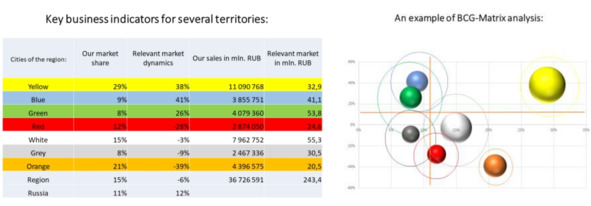
Please be ready to analyze business potential of every city in the BCG-Matrix and give your arguments and proofs presenting their business strategies.
When the strategy for a territory is determined a regional manager can set a business objective for this territory for the next year or promotional cycle. Business objectives are usually set in terms of market share (in percent) and in sales volume (in money/packages).
Let us do it together, for example, for BLUE city. As we can see this city is placed in the upper left segment of the BCG-Matrix which means that it has very high business potential (compared to business potential of the country). Our main conclusions are:
• relevant business dynamics in this city is 3,5 times higher than in the country (41% vs 12%);
• our product market share is less than in the country (9% vs 11%) which means that it can be increased;
• our sales in this city are comparable with sales in GREEN and ORANGE and exceeds our sales in GREY, RED;
• Relevant market in this city exceeds all other citied (even YELLOW one) except WHITE and GREEN (=very big business potential).
If positive tendencies of business development in BLUE city remain (relevant market dynamics growth) the regional manager can set the following business objectives:
• MAX objective in terms of our product market share – to reach 15% of relevant market share;
• MIN objective (if business development in the city is unstable) – to reach 12% of relevant market share.
Now that we know our business objectives in terms of market share and have a forecast for the relevant market for the next year (let’s say +10% growth vs this year = 4,2 mln. RUB) we can easily calculate our MAX sales objectives in BLUE for the next year: 4,2 mln. RUB x 15% = 0,62 mln. RUB. Our MIN sales objectives will be: 4,2 mln. RUB x 12% = 0,5 mln. RUB.
Учебный модуль №3. Новые слова

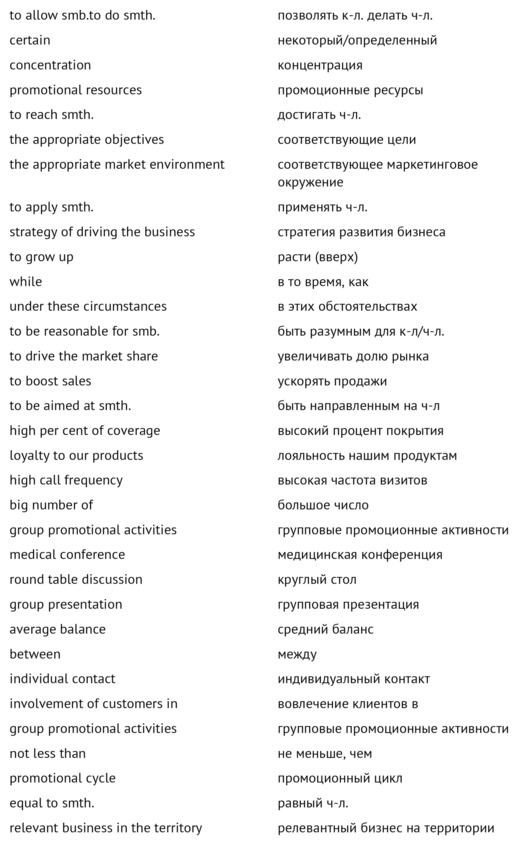
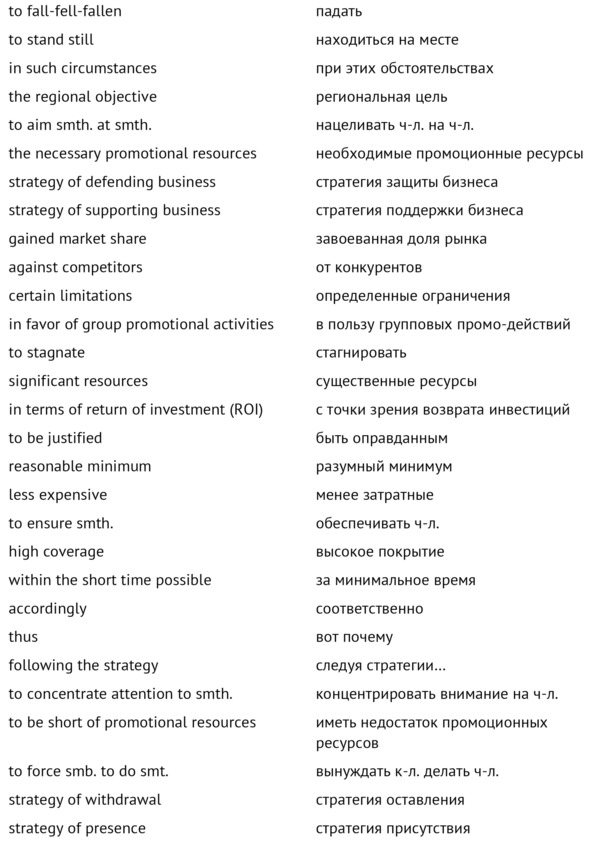
Учебный модуль №4.
Работа над текстом и грамматикой
Задание №1: Прочитайте и переведите текст с опорой на аудиозапись.
Задание №2: Устно ответьте на следующие вопросы с опорой на текст:
1. What is the first step in the territory management?
2. What are the key marketing indicators reflecting the territory potential?
3. How should manager compare the key marketing indicators?
4. What is the result of comparison of key marketing indicators in terms of time (one year vs another)?
5. What is a business strategy?
6. What business strategies do you know?
7. When does a regional manager choose the strategy of driving the business?
8. What is the strategy of driving the business aimed at?
9. What are the main elements of strategy of driving the business?
10. What can you say about the balance between individual contacts and group promotional activities in the strategy of driving the business?
11. In what circumstances is it reasonable for the company to invest high promotional resources in the territory?
12. In what circumstances is it not reasonable for the company to invest high promotional resources in the territory?
13. When is the strategy of defending the business chosen?
14. What is the objective of the strategy of defending the business?
15. What does the strategy of defending the business mean for the regional team?
16. What does the strategy of defending the business mean in terms of promotional activities?
17. What is the average balance between individual contacts and group activities for the strategy of defending the business?
18. Why is the investment of significant resources for the strategy of presence in the territory not justified?
19. What is the main form of promotional activity for the strategy of presence?
20. When does the regional manager start to implement the strategy of withdrawal in the territory?
Задание №3: Устно завершите приведенные ниже фразы с опорой на текст:
1. An effective territory management starts with…
2. For effective territory management the first thing to do is…
3. The key marketing indicators for an effective territory analysis are ….
4. Each of the key market indicators is analyzed in terms…
5. To visualize a potential business strategy for a product/business in a territory managers are recommended…
6. BCG-Matrix was developed by…
7. A Business Strategy – is…
8. Two main scales of the BCG-Matrix represent…
9. The lines marked red in the BCG-Matrix show…
10. Each of the four segment of the BCG-Matrix…
11. The main business strategies for a territory are…
12. An important benchmark for business potential analysis…
13. The strategy of driving the business is chosen when…
14. For the strategy of driving the business it is reasonable…
15. The strategy of driving the business is aimed at…
16. The average balance between individual calls and group promotional activities for the strategy of driving the business…
17. This balance (6+2) is given for…
18. The strategy of defending the business is chosen when…
19. For the strategy of defending the business it is reasonable…
20. The strategy of defending the business is aimed at…
21. The average balance between individual calls and group promotional activities for the strategy of defending the business…
22. The strategy of supporting business means…
23. Sometimes when the regional manager is short of promotional resources and the relevant business dynamics is falling down…
24. If you want to analyze some real territory potential and business strategy…
25. A regional manager sets business objective for this territory for…
26. Business objectives are usually set in terms of…
27. A regional manager sets MAX objectives for the territory when…
28. A regional manager set MIN objectives for the territory when…
29. A regional manager first sets objectives …. and then ….
30. Sales objectives can easily be calculated…
Задание №4: Устно прореагируйте на следующие реплики. Исправьте утверждения, не соответствующие содержанию текста:
1. An effective territory management starts with deep business analysis.
2. For effective territory management the first thing to do is to get a marketing forecast.
3. The key marketing indicators for an effective territory analysis are relevant market and our product sales.
4. Each of the key market indicators is analyzed in terms of time (year vs year) and in terms of territory (a smaller territory vs a bigger territory).
5. To visualize potential business strategy for a product/business in a territory managers are recommended to analyze a market forecast.
6. BCG-Matrix was developed by a group of American market specialists.
7. A Business Strategy is a process of setting business objective for some territory.
8. Two main scales of the BCG-Matrix represent relevant market and our sales.
9. The lines marked red in the BCG-Matrix show average country indicators.
10. Each of the four segment of the BCG-Matrix represents some business strategy.
11. The main business strategies for a territory are the strategy of attack and the strategy of defense.
12. The strategy of driving the business is chosen when the relevant business falls down and our market share is high.
13. For the strategy of driving the business it is reasonable to save resources.
14. The strategy of driving the business is aimed at increasing our market share.
15. The average balance between individual calls and group promotional activities for the strategy of driving the business should be about 3+3.
16. The strategy of defending the business is chosen when the company needs to keep our market share.
17. For the strategy of defending the business it is reasonable to invest a lot of resources in the territory.
18. The strategy of defending the business is aimed at increasing our market share.
19. The average balance between individual calls and group promotional activities for the strategy of defending the business is about 6+2.
20. The strategy of supporting business means that we make emphasis on group promotional activities.
21. Sometimes when the regional manager is short of promotional resources and the relevant business dynamics is falling down the company can implement the strategy of driving the business.
22. If you want to analyze some real territory potential and business strategy you need reliable information.
23. A regional manager sets business objective for this territory for the period of three months.
24. Business objectives are always set in terms of sales/money.
25. A regional manager first sets objectives in terms of sales and only then in terms of market share.
Задание №5: Письменно поставьте повествовательные предложения в отрицательную и вопросительную форму:
1. An effective territory management starts with deep business analysis.
2. The regional manager has analyzed the key marketing indicators for a business strategy.
3. All key market indicators must be analyzed in terms of time (year vs year) and in terms of territory.
4. BCG Matrix is recommended to visualize potential business strategy for a product/business.
5. BCG-Matrix was developed by a group of Canadian market specialists.
6. A Business Strategy is a process of setting business objective and calculating promotional resources for the territory.
7. Two main scales of the BCG-Matrix represent relevant market and our product market share.
8. The lines marked red in the BCG-Matrix show the average country indicators in relevant market dynamics and in our product market share.
9. Each of the four segment of the BCG-Matrix represents some business strategy.
10. The most ambitious business strategy for a territory is the strategy of driving the business.
11. The strategy of driving the business is chosen when the relevant business grows and our market share is small.
12. For the strategy of driving the business it is reasonable to invest a lot of resources.
13. The strategy of driving the business is aimed at increasing our market share.
14. The average balance between individual calls and group promotional activities for the strategy of driving the business should be about 6+3.
15. The strategy of defending the business is chosen when the company needs to keep our market share.
16. The average balance between individual calls and group promotional activities for the strategy of defending the business is about 3+3.
17. The strategy of supporting business means that we make emphasis on group promotional activities.
18. Our company is ready to implement the strategy of driving the business.
19. You need reliable information.
20. A regional manager sets business objective for this territory for the period of three months.
21. Business objectives are always set in terms of sales and money.
22. A regional manager first sets objectives in terms of sales.
Задание №6: Письменно задайте вопросы к подчеркнутым словам в предложении:
1. An effective territory management starts with deep business analysis.
2. The regional manager has analyzed the key marketing indicators for a business strategy.
3. All key market indicators must be analyzed in terms of time (year vs year) and in terms of territory.
4. BCG Matrix is recommended to visualize potential business strategy for a product/business.
5. BCG-Matrix was developed by a group of Canadian market specialists.
6. Two main scales of the BCG-Matrix represent relevant market and our product market share.
7. The lines marked red in the BCG-Matrix show the average country indicators in relevant market dynamics and in our product market share.
8. Each of the four segment of the BCG-Matrix represents some business strategy.
9. The strategy of driving the business is chosen when the relevant business grows and our market share is small.
10. For the strategy of driving the business it is reasonable to invest a lot of resources.
11. The strategy of driving the business is aimed at increasing our market share.
12. The average balance between individual calls and group promotional activities for the strategy of driving the business should be about 6+3.
13. The strategy of defending the business is chosen when the company needs to keep our market share.
14. The strategy of supporting business means that we should make emphasis on group promotional activities.
15. Our company is ready to implement the strategy of driving the business.
16. You need reliable information.
17. A regional manager sets business objective for this territory for the period of three months.
18. Business objectives are always set in terms of sales and money.
19. A regional manager first sets objectives in terms of sales.
Учебный модуль №5.
Слова и выражения для диалогов по теме
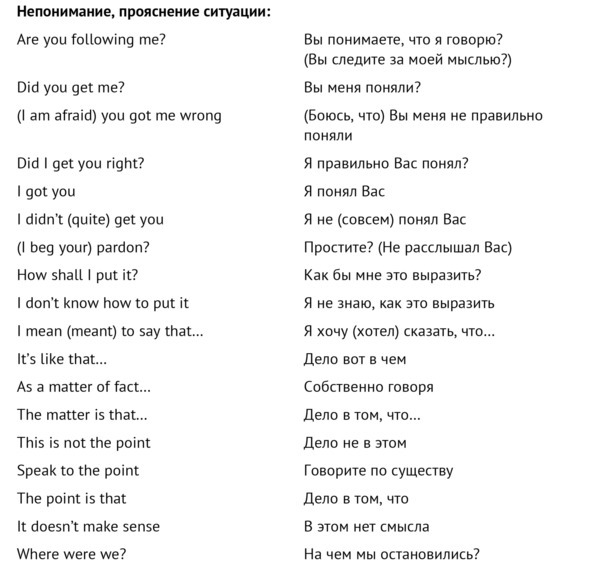
Задание №8: Устно ответьте на вопросы, используя фразы в скобках:
1. Did you get me? (Yes, I got you. No, I didn’t get you. I’m afraid not. I don’t think I did. Not at all. Yes, certainly.)
2. Did I get you right? (Not quite. I don’t think you did. Quite right. No, I am afraid you got me wrong. I believe so. Looks like that. No, this is not the point.)
3. Are you following me? (Yes, certainly. I think so. I don’t think I am. I’m afraid not. Not quite.
4. Where were we? (You were telling me about… You were speaking about… I was telling you about… We were discussing …You were going to say something about…)
Задание №9: Отвечая устно на приведенные ниже высказывания, используйте следующие фразы:
I mean to say that… It’s like this…I meant to say that… As a matter of fact…The matter is that…1. I’m afraid I didn’t get you.
2. Did I get you right?
3. I beg your pardon?
4. Pardon?
5. I didn’t quite get you.
6. I am afraid it doesn’t make sense to me.
Задание №10: Подберите устно соответствующие друг-другу высказывания в различных частях таблицы. Закончите фразы в правой колонке:

Задание №11: Письменно приведите высказывания, соответствующие следующим фразам:
Model: …you didn’t understand the person you are talking to?
If I didn’t understand the person I am talking to I would say: I beg your pardon?
…you want someone to repeat what he said because you didn’t understand (hear it)?
…you are not sure the person you are talking to understands what you are saying?
…you want somebody to give additional explanation?
…you don’t remember what you were talking about when you were interrupted?
…you don’t know how to express some idea?
Задание №12: Письменно переведите следующие предложения на английский язык:
1. Андрей Титов – хороший медицинский представитель. Я в этом с Вами совершенно согласен.
2. Он часто работает в офисе. Я в этом с Вами не согласен, потому что Андрей всегда работает в «поле».
3. Я думаю, что презентация займет (will take) около получаса. Вы правы.
4. Могу ли я доехать (get …) до поликлиники автобусом? Конечно.
5. Мы будем работать на выставке? Само собой разумеется.
6. У нас достаточно времени еще на один визит? Совсем нет.
7. Это так трудно. Наоборот, это очень легко.
8. Сегодня вторник. Простите, но сегодня среда.
9. Когда состоится цикловая конференция компании? Понятия не имею.
10. Доктор выписал несколько рецептов. Похоже на то.
11. Я правильно Вас понял? Боюсь, что нет. Я хотел сказать, что это невозможно.
12. Боюсь, что я Вас не понял. Говорите, пожалуйста, по существу.
13. Простите (я Вас не расслышал)? Собственно говоря, это не так важно.
14. На чем мы остановились? Вы говорили мне о своих планах на следующую неделю.
15. Простите, я Вас не понял. Ну, как бы это сказать. Дело в том, что все это довольно необычно.
16. Это не имеет смысла. Пожалуйста, говорите по существу.
17. Вы знаете, что он хотел сказать? Да, дело в том, что он нашел несколько новых медицинских учреждений на своей территории.
18. Не знаю, как это выразить. В сущности говоря, он прав.
19. Не в этом дело. Дело в следующем.
Задание №13: С опорой на новые слова подготовьте краткий диалог (3—4 вопроса/ответа) на тему: Матрица BCG – инструмент для выбора стратегии бизнеса на территории.
Задание №14: С опорой на новые слова подготовьте краткий диалог (3—4 вопроса/ответа) на тему: Основные бизнес условия для выбора стратегии развития бизнеса на территории.
Задание №15: С опорой на новые слова подготовьте краткий диалог (3—4 вопроса/ответа) на тему: Как поставить бизнес цель для территории в рамках выбранной промоционной стратегии.
Учебный модуль №6.
Контрольная работа по теме №3
Задание: Письменно переведите предложения на английский язык
1. Вам следует начать анализ с объективной оценки потенциала территории.
2. Чтобы понять динамику, ему пришлось сравнить два бизнес индикатора территории по времени (2019 с 2020).
3. Чтобы визуализировать потенциальную бизнес стратегию по продукту/бизнесу на территории, Вы можете использовать BCG-Матрицу.
4. Бизнес стратегия – это обоснованная концентрация промоционных ресурсов для достижения соответствующих целей в соответствующих рыночных условиях. Я полностью с Вами здесь согласен!
5. Как Вы видите, в этих условиях нам придется выбрать стратегию защиты нашего бизнеса, потому что наша доля рынка – высокая, а рынок падает.
6. Дело в том, что на растущем рынке для компании разумно инвестировать большие промоционные ресурсы, чтобы увеличить долю рынка и ускорить рост продаж.
7. В сущности, средний баланс между индивидуальными контактами с врачами и их участием в групповых промоционных активностях не должен превышать 2+3 для промоционного цикла.
8. Если у менеджера не хватает промоционных ресурсов на территории он/она может (им позволено) выбрать стратегию сворачивания бизнеса.
9. Почему она не смогла проанализировать и представить потенциал территории?
10. Если позитивные тенденции развития бизнеса в городе СИНИЙ сохраняться, менеджер может поставить территориальной команде очень амбициозные задачи.
11. Нам необходимо выбрать стратегию развития бизнеса для города СИНИЙ. Я в этом с Вами полностью согласен!
12. Чтобы реализовать эту стратегию, мне необходимо много промоционных ресурсов. – Само собой разумеется!
13. Я правильно Вас понял? Вы пытаетесь (to try) сказать, что мы должны прекратить нашу промоционную активность на этой территории?
14. Боюсь, что Вы меня не правильно поняли. Я не могу дать Вам дополнительные ресурсы для этой территории.
15. Я имею в виду, что наша команда не сможет добиться амбициозных целей без дополнительных промоционных ресурсов.
16. Ваш анализ не имеет смысла! – Нет, имеет.
17. Я не понял Вас. Вы его защищаете? – Совсем наоборот!
18. Я правильно Вас понял? – Боюсь, что нет. Я имею в виду, что не могу помочь Вам с промоционными ресурсами.
19. Боюсь, что я Вас не понял. Пожалуйста, говорите по существу!
20. Не знаю, как это выразить. В сущности, он – прав!
Учебный модуль №7. «Ключи» для проверки правильности выполнения заданий
Работа с текстом: перевод и заучивание (выделено жирным шрифтом)

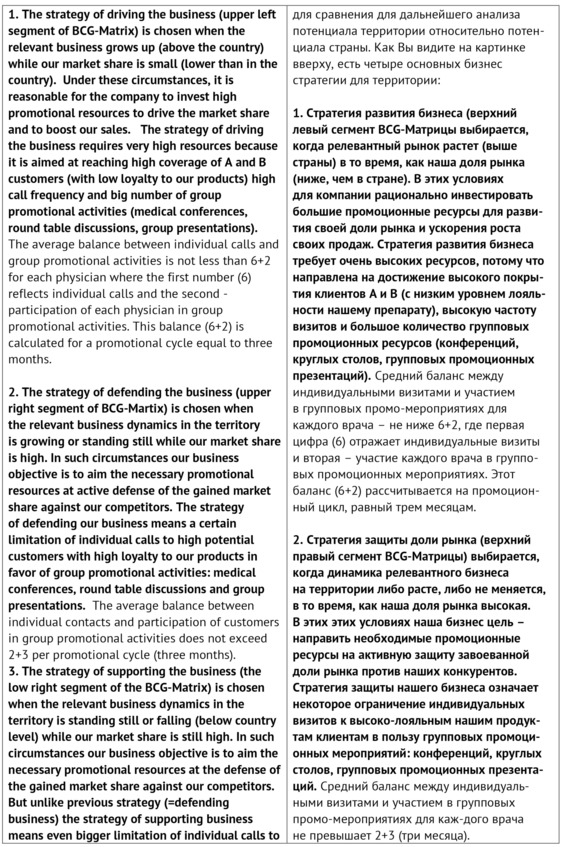

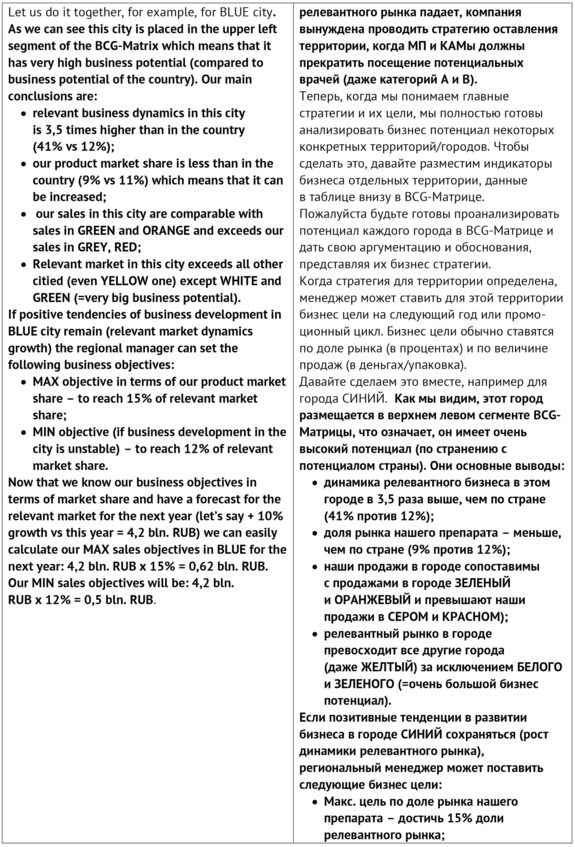
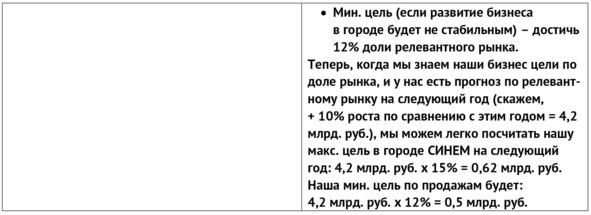
Задание №5: Письменно поставьте повествовательные предложения в отрицательную и вопросительную форму:
1. An effective territory management doesn’t start with deep business analysis/Does an effective territory management start with deep business analysis?
2. The regional manager hasn’t analyzed the key marketing indicators for a business strategy/Has the regional manager analyzed the key marketing indicators for a business strategy?
3. All key market indicators mustn’t be analyzed in terms of time (year vs year) and in terms of territory/ Must all key market indicators be analyzed in terms of time (year vs year) and in terms of territory?
4. BCG Matrix isn’t recommended to visualize potential business strategy for a product/business/ Is BCG Matrix recommended to visualize potential business strategy for a product/business?
5. BCG-Matrix wasn’t developed by a group of Canadian market specialists/Was BCG-Matrix developed by a group of Canadian market specialists?
6. A Business Strategy is not a process of setting business objective and calculating promotional resources for the territory/ Is Business Strategy a process of setting business objective and calculating promotional resources for the territory?
7. Two main scales of the BCG-Matrix don’t represent relevant market and our product market share/Do two main scales of the BCG-Matrix represent relevant market and our product market share?
8. The lines marked red in the BCG-Matrix don’t show the average country indicators in relevant market dynamics and in our product market share/Do the lines marked red in the BCG-Matrix show the average country indicators in relevant market dynamics and in our product market share?
9. Each of the four segment of the BCG-Matrix doesn’t represent some business strategy/ Does each of the four segment of the BCG-Matrix represent some business strategy?
10. The most ambitious business strategy for a territory isn’t the strategy of driving the business/Is the most ambitious business strategy for a territory the strategy of driving the business?
11. The strategy of driving the business isn’t chosen when the relevant business grows and our market share is small/ Is the strategy of driving the business chosen when the relevant business grows and our market share is small?



